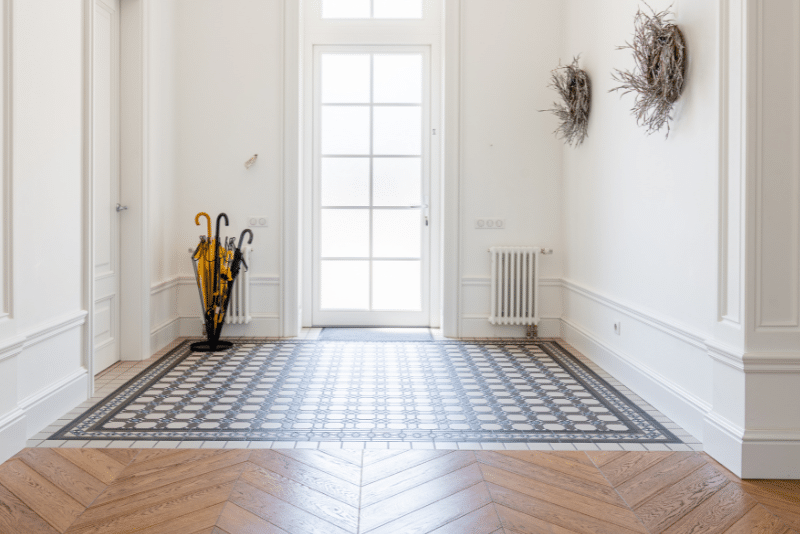How to Combine Tile and Wood Flooring

If you’re looking to add a touch of uniqueness to your home’s flooring, combining tile and wood can be an excellent option. While both materials have their individual beauty, combining them can create a unique and stunning look that will set your home apart. In this article, we’ll take you through the basics of tile and wood flooring, planning for installation, and finally, how to install them for a seamless finish.
Understanding the Basics of Tile and Wood Flooring
When it comes to selecting the right flooring for your home, there are many factors to consider. One of the most important is the type of material you choose. Two of the most popular options are tile and wood flooring. Before you begin selecting the right combination of wood and tile and preparing your floor, it’s essential to understand the basics of each material.
Tile flooring is generally made from ceramic, porcelain, or natural stone. Ceramic tile is affordable and comes in various sizes, colors, and patterns. Porcelain tiles are a type of ceramic tile but are more dense, making them more durable and water-resistant. Natural stone tiles provide a unique and natural texture to the room but require sealing and maintenance to avoid damage. Tile flooring is known for its durability, water, and stain-resistant properties. It’s an excellent choice for high-traffic areas or rooms prone to moisture, such as bathrooms and kitchens.
Wood flooring, on the other hand, is a natural material that adds warmth and character to a room. Hardwood is a popular choice for flooring and comes in various species and shades to complement your design style. It’s an excellent choice for living rooms, bedrooms, and other areas where you want to create a cozy atmosphere. However, wood flooring can be prone to damage from water and humidity. That’s why it’s essential to consider the maintenance required for each material and how it suits your lifestyle.
Types of Tile Flooring
As mentioned earlier, there are three primary types of tile flooring: ceramic, porcelain, and natural stone. Ceramic tile is the most affordable option and is available in various sizes, colors, and patterns. Porcelain tiles are a type of ceramic tile but are more dense, making them more durable and water-resistant. They are an excellent choice for high-traffic areas or rooms prone to moisture. Natural stone tiles provide a unique and natural texture to the room but require sealing and maintenance to avoid damage. They are a beautiful choice for adding a touch of luxury to your home.
Types of Wood Flooring
There are several types of wood flooring to choose from, including hardwood, engineered wood, and laminate. Hardwood is a popular choice for flooring and comes in various species and shades to complement your design style. It’s a natural material that adds warmth and character to a room. Engineered wood is another option, consisting of a thin layer of hardwood bound to a plywood base, making it more resistant to moisture. Laminate flooring is a synthetic floor covering that imitates the look of wood. It’s an affordable and durable option that’s easy to install.
Pros and Cons of Each Material
While both tile and wood have their individual benefits, it’s important to consider how they’ll complement each other before selecting your materials. Tile may be more durable in high-traffic areas or rooms prone to moisture, while wood adds warmth and character to a room. It’s also essential to consider the maintenance required for each material and how it suits your lifestyle. For example, if you have pets or young children, you may want to choose a flooring material that’s easy to clean and maintain.
Ultimately, the choice between tile and wood flooring comes down to personal preference and the specific needs of your home. By understanding the basics of each material and considering the pros and cons, you can make an informed decision that will enhance the beauty and functionality of your home for years to come.
Planning Your Combined Flooring Design
Once you’ve selected your tile and wood materials, it’s time to plan for installation. Your design must take into consideration the color, texture, pattern, and material of each floor type. You’ll want to decide how much of each material you’ll be using in the room and how they’ll be laid out. When combining tile and wood, you’ll want to create a seamless transition that fits the style of your interior design.
When planning your combined flooring design, there are several factors to consider. One of the most important is the overall aesthetic you’re trying to achieve. Are you going for a rustic look, a modern feel, or something in between? This will help you determine which materials and colors will work best together.
Another important consideration is the size of the room. If you’re working with a small space, you may want to choose lighter colored materials to create the illusion of a larger room. Conversely, if you’re working with a large space, you may want to use darker colors to create a cozier feel.
Choosing the Right Tile and Wood Combination
When choosing a combination, you’ll need to consider the color and texture of each material. Ideally, you’ll want to choose colors and textures that complement each other. For example, a natural wood floor will pair well with a neutral-toned porcelain or ceramic tile.
It’s also important to consider the durability of each material. Wood floors are susceptible to scratches and dents, while tile floors are more resistant to wear and tear. If you have pets or young children, you may want to choose a more durable material for the majority of the flooring.
Determining the Layout and Pattern
When laying out your design, you’ll want to decide on the pattern and layout of each flooring type. Depending on the material and pattern, you can create a focal point or seamlessly blend the two materials. It’s also important to consider the traffic flow and where each material will best serve its purpose.
If you’re using a patterned tile, you may want to consider using a simpler pattern for the wood flooring. This will help prevent the design from becoming too busy or overwhelming.
Considering Room Transitions and Flow
Another crucial aspect to consider is how the transition between the two materials will look. You’ll want to ensure a smooth and seamless transition that complements your interior design style. It’s essential to consider the flow of the room and how each material will affect it.
If you’re transitioning from tile to wood, you may want to consider using a transition strip to create a defined border between the two materials. This can help prevent tripping hazards and create a more polished look.
In conclusion, combining tile and wood flooring can create a beautiful and unique look in your home. By considering the color, texture, pattern, and layout of each material, you can create a design that complements your interior style and meets your functional needs.
Preparing for Installation
Before beginning the installation process, it’s essential to ensure that you have all the necessary tools and materials. You’ll also want to assess the subfloor and ensure that it’s level, clean, and free of defects. Properly preparing the subfloor will ensure that the installation process goes smoothly and that the finished product will look professional.
Gathering Necessary Tools and Materials
You’ll need a range of tools for laying your tiles, such as a tile cutter, a rubber mallet, and spacers. For wood flooring, a saw and floor nailer will be necessary. Additionally, you’ll need to purchase the wood and tile materials and any necessary adhesives or grout.
Preparing the Subfloor
The subfloor should be level and free of imperfections to prevent any uneven tile or wood flooring. Once you’ve assessed the subfloor, you may need to install a layer of leveling compound or underlayment to ensure it’s flat and level.
Ensuring Proper Expansion Gaps
Wood flooring may expand and contract with changes in temperature and humidity. Ensure adequate expansion gaps are made along the perimeter of the room and any fixed objects to maintain the integrity of the flooring.
Installing the Tile and Wood Flooring
Laying the Wood Flooring
First, you’ll need to acclimate your wood flooring for a few days to the temperature and humidity of the room before installation. Once acclimated, lay out your flooring according to your design plan, using spacers to ensure a gap between the wood and tile. Use a floor nailer to secure your wood flooring to the subfloor.
Laying the Tile Flooring
Begin by laying out your tile according to your design plan, using spacers to maintain an even gap between the tiles. Use a tile cutter to make cuts around the edges of the room or where needed. Once laid out, mix and apply grout to fill in the gaps between the tiles.
Creating Seamless Transitions
Finally, use transition strips or complementary tiles to create a seamless transition between the wood and tile sections of the floor. The transition should blend the two materials together without creating a noticeable division.
Conclusion
Combining tile and wood flooring can create a unique and stunning look in any home. By understanding the basics of each material, planning your design, preparing for installation, and properly installing your materials, you can create a seamless and professional finish. Remember to consider the layout, color, texture, and flow of the room when combining tile and wood flooring. With a little planning and effort, you’ll have a unique and eye-catching flooring design that will add value and beauty to your home.



